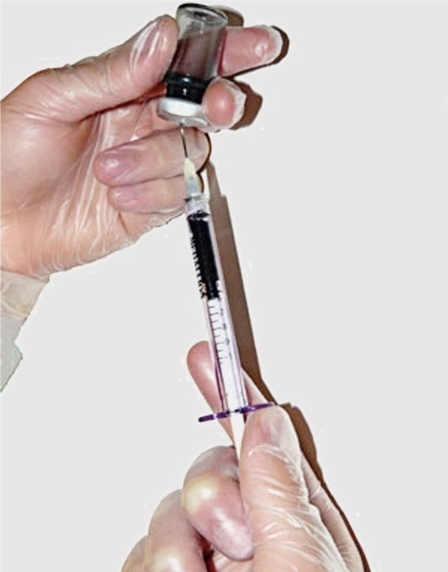DiscoGel™ (CE-marked implantable device, opaque gelified ethanol, radiopaque gelified ethanol)
DiscoGel is a relatively new form of chemonucleolysis used for the treatment of symptomatic contained disc herniations and  their sequelae (i.e., low back pain and/or lower limb pain). their sequelae (i.e., low back pain and/or lower limb pain).
More specifically, the injectionist administers, through a far lateral approach, a ~1 mL mixture of gelified ethanol, tungsten (to make the goop radiopaque (visible) {you can’t see it on x-ray, fluoroscopy, CT) and ethylcellulose (makes the mixture more viscous – like a cotton ball – so it is less likely to leak out of an annular tear into the epidural space and negatively affect the adjacent neuron structures) into the center of the disc, under fluoroscopic guidance.
As with any pure alcohol-based product, DiscoGel will destroy the cells and substance of the nucleus pulposus which in turn ostensibly “shrinks the disc” and its periphery. The shrinking may reduce the size of the disc bulge and/or disc herniation and therefore remove irritating pressure on an affected nerve root.
Warning: this is still completely experimental, and I did not see a single randomized-controlled trial or meta-analysis in the current (2016) medical literature database. I don’t think it is licensed for used in the United States.
Warning: there is always a risk of adjacent neural structure damage if the DiscoGel material leaks out of a torn disc which may cause arachnoiditis, increased radicular pain (sciatica [Theron-2007] or permanent nerve root damage or maybe worse – we just don’t know yet.
My Comments: as I’ve said in numerous areas of my website, we know from sheep and human studies that poking the disc with the needle, which is necessitated with all these disc volume reduction techniques, may well have deleterious effects in the long run. Specifically, the needle-stick often greatly speeds up the degenerative process within that disc which leads to chronic discogenic pain, facet joint pain, new annular tear, and new disc herniations. Therefore, I personally never recommend any of these minimally invasive “disc shrinking procedures” unless they are used as a last-ditch effort to avoid interbody fusion.
MEDICAL RESEARCH
In 2015, Leglise et al publish the results of their retrospective review of 25 patients treated with DiscoGel, all of whom were treated in France. Although this was not a very well done study and obviously way underpowered (not enough patients to really make a statistical statement about), they found that in 64% of the patients, the treatment failed.
In 2013, de Seze et al publish the results of their prospective French study on 79 patients undergoing the DiscoGel procedure. There were no serious complications and 63% of the patients reported excellent outcomes.
In 2015, Mackenzie et al reported the one-year results of nine dogs whose discs were injected with DiscoGel. Worrisome was the fact that epidural leakage (the DiscoGel leaked out of the disc and into the epidural space which is where the delicate nerves are) occurred in 33% of the animals injected initially and in another 11% of the animals within the one year follow-up. Therefore, all in all 36% of the animals suffered epidural leakage. There were, however, no noted clinically adverse reactions.
In 2015, Belini et al reported the results of 80 patients treated with radiopaque gelified ethanol. Leakage of the injected occurred in 24% of the patients. The follow-up period was unknown; however, 85% of the patients with lumbar disc herniation had at least a 40% reduction of the VAS and ODI.
|

